HND Unit 11 Research Project: Contactless Payment Technology in UK
VerifiedAdded on 2023/06/04
|29
|9129
|94
Project
AI Summary
This research project investigates the perceived risks associated with contactless payment technology in the United Kingdom market. It explores the benefits and weaknesses of the technology, customer perceptions, and behavioral intentions. Using the Technology Acceptance Model (TAM) as a theoretical framework, the study examines factors influencing the acceptance of contactless payments, including perceived usefulness, ease-of-use, and attitudes towards use. The research employs a mixed-methods approach, utilizing both quantitative (survey questionnaires) and qualitative (literature review) data collection techniques. Key themes identified include perceived usefulness, perceived ease-of-use, attitudes towards use, and behavioral intention to use. The study concludes by offering recommendations for promoting the acceptance of contactless technology and addressing customer concerns regarding security and privacy. Desklib provides access to this and other solved assignments for students.

Contactless technology is a transactional
technology which can gain traction in UK. the
technology reduces queuing times and creates
faster payments. Technology Acceptance Model
is used that models how the users should accept
and use the technology. The proposed
technology model is suitable in UK market which
can aid scholars to measure market receptivity
of the contactless cards. Questionnaires are
constructed using measures to reflect customer
perceptions in relation to payment
technologies. Results from the respondents
show that acceptance is positively influenced by
perceived risks and usefulness.
Research Project
HND Unit 11: Research Project 2017-18
…………………
Word Count / 5,000
technology which can gain traction in UK. the
technology reduces queuing times and creates
faster payments. Technology Acceptance Model
is used that models how the users should accept
and use the technology. The proposed
technology model is suitable in UK market which
can aid scholars to measure market receptivity
of the contactless cards. Questionnaires are
constructed using measures to reflect customer
perceptions in relation to payment
technologies. Results from the respondents
show that acceptance is positively influenced by
perceived risks and usefulness.
Research Project
HND Unit 11: Research Project 2017-18
…………………
Word Count / 5,000
Paraphrase This Document
Need a fresh take? Get an instant paraphrase of this document with our AI Paraphraser
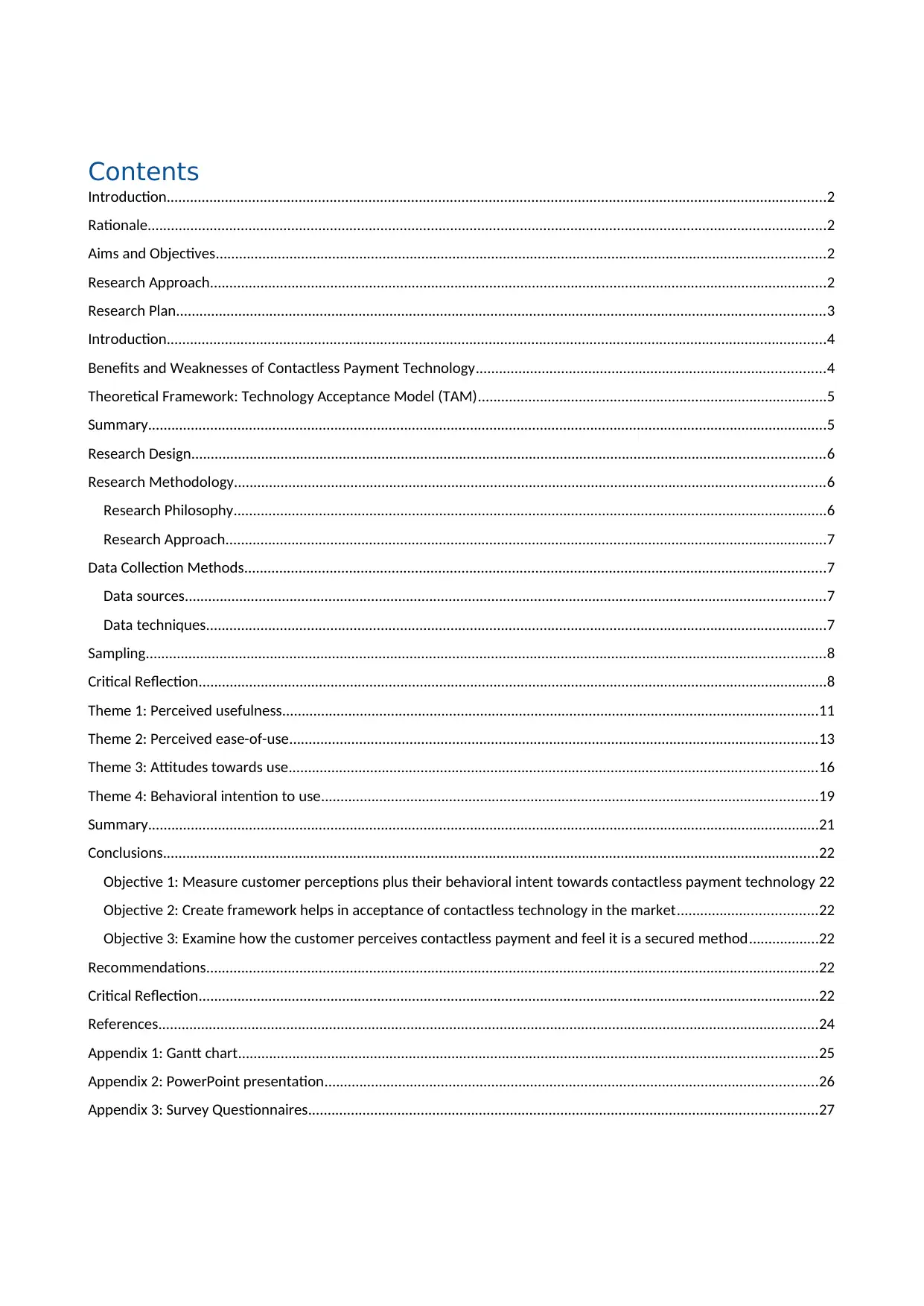
Contents
Introduction..........................................................................................................................................................................2
Rationale...............................................................................................................................................................................2
Aims and Objectives.............................................................................................................................................................2
Research Approach...............................................................................................................................................................2
Research Plan.......................................................................................................................................................................3
Introduction..........................................................................................................................................................................4
Benefits and Weaknesses of Contactless Payment Technology..........................................................................................4
Theoretical Framework: Technology Acceptance Model (TAM)..........................................................................................5
Summary...............................................................................................................................................................................5
Research Design...................................................................................................................................................................6
Research Methodology........................................................................................................................................................6
Research Philosophy.........................................................................................................................................................6
Research Approach...........................................................................................................................................................7
Data Collection Methods......................................................................................................................................................7
Data sources.....................................................................................................................................................................7
Data techniques................................................................................................................................................................7
Sampling...............................................................................................................................................................................8
Critical Reflection..................................................................................................................................................................8
Theme 1: Perceived usefulness..........................................................................................................................................11
Theme 2: Perceived ease-of-use........................................................................................................................................13
Theme 3: Attitudes towards use........................................................................................................................................16
Theme 4: Behavioral intention to use................................................................................................................................19
Summary.............................................................................................................................................................................21
Conclusions.........................................................................................................................................................................22
Objective 1: Measure customer perceptions plus their behavioral intent towards contactless payment technology 22
Objective 2: Create framework helps in acceptance of contactless technology in the market....................................22
Objective 3: Examine how the customer perceives contactless payment and feel it is a secured method..................22
Recommendations..............................................................................................................................................................22
Critical Reflection................................................................................................................................................................22
References..........................................................................................................................................................................24
Appendix 1: Gantt chart.....................................................................................................................................................25
Appendix 2: PowerPoint presentation...............................................................................................................................26
Appendix 3: Survey Questionnaires...................................................................................................................................27
Introduction..........................................................................................................................................................................2
Rationale...............................................................................................................................................................................2
Aims and Objectives.............................................................................................................................................................2
Research Approach...............................................................................................................................................................2
Research Plan.......................................................................................................................................................................3
Introduction..........................................................................................................................................................................4
Benefits and Weaknesses of Contactless Payment Technology..........................................................................................4
Theoretical Framework: Technology Acceptance Model (TAM)..........................................................................................5
Summary...............................................................................................................................................................................5
Research Design...................................................................................................................................................................6
Research Methodology........................................................................................................................................................6
Research Philosophy.........................................................................................................................................................6
Research Approach...........................................................................................................................................................7
Data Collection Methods......................................................................................................................................................7
Data sources.....................................................................................................................................................................7
Data techniques................................................................................................................................................................7
Sampling...............................................................................................................................................................................8
Critical Reflection..................................................................................................................................................................8
Theme 1: Perceived usefulness..........................................................................................................................................11
Theme 2: Perceived ease-of-use........................................................................................................................................13
Theme 3: Attitudes towards use........................................................................................................................................16
Theme 4: Behavioral intention to use................................................................................................................................19
Summary.............................................................................................................................................................................21
Conclusions.........................................................................................................................................................................22
Objective 1: Measure customer perceptions plus their behavioral intent towards contactless payment technology 22
Objective 2: Create framework helps in acceptance of contactless technology in the market....................................22
Objective 3: Examine how the customer perceives contactless payment and feel it is a secured method..................22
Recommendations..............................................................................................................................................................22
Critical Reflection................................................................................................................................................................22
References..........................................................................................................................................................................24
Appendix 1: Gantt chart.....................................................................................................................................................25
Appendix 2: PowerPoint presentation...............................................................................................................................26
Appendix 3: Survey Questionnaires...................................................................................................................................27
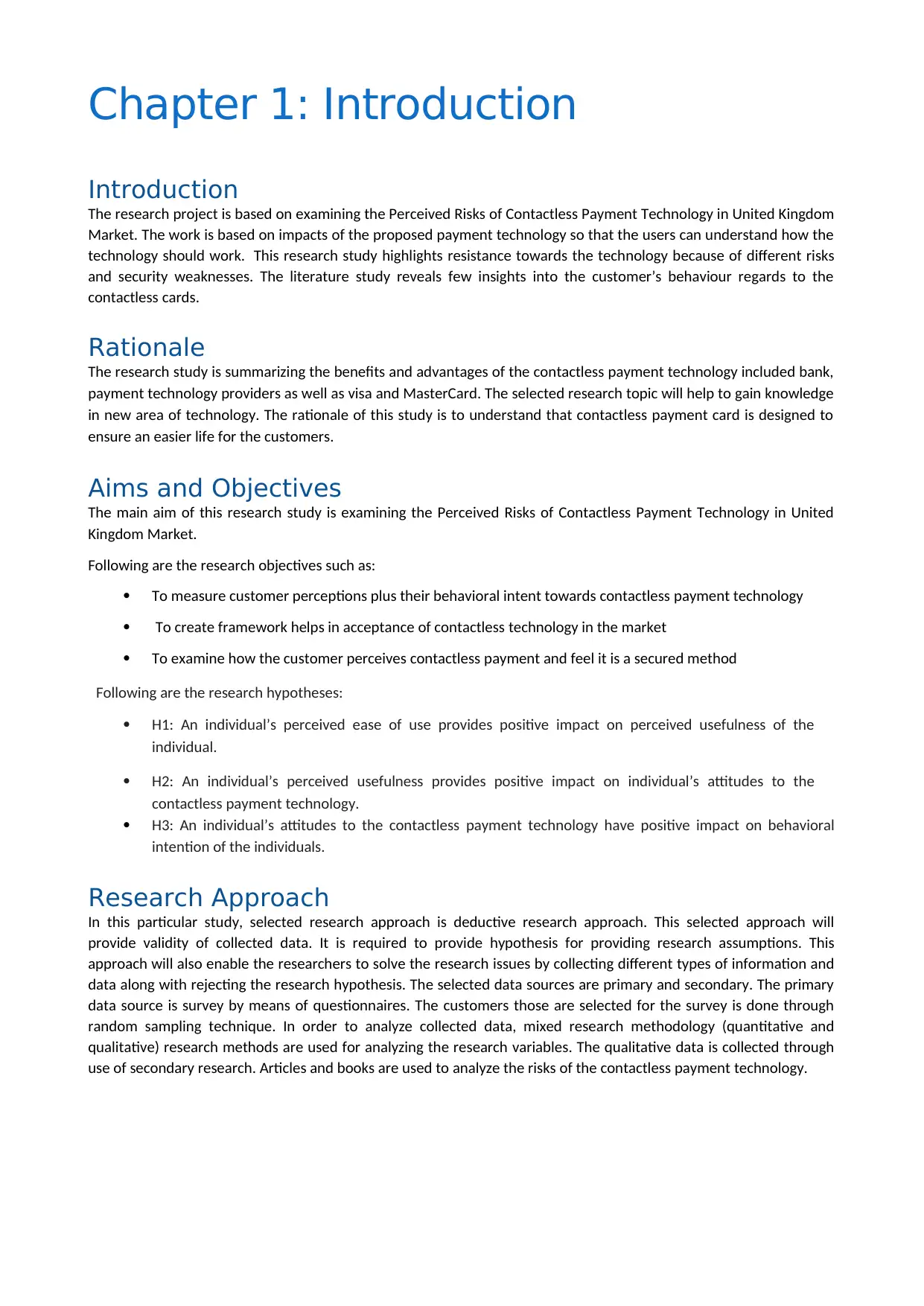
Chapter 1: Introduction
Introduction
The research project is based on examining the Perceived Risks of Contactless Payment Technology in United Kingdom
Market. The work is based on impacts of the proposed payment technology so that the users can understand how the
technology should work. This research study highlights resistance towards the technology because of different risks
and security weaknesses. The literature study reveals few insights into the customer’s behaviour regards to the
contactless cards.
Rationale
The research study is summarizing the benefits and advantages of the contactless payment technology included bank,
payment technology providers as well as visa and MasterCard. The selected research topic will help to gain knowledge
in new area of technology. The rationale of this study is to understand that contactless payment card is designed to
ensure an easier life for the customers.
Aims and Objectives
The main aim of this research study is examining the Perceived Risks of Contactless Payment Technology in United
Kingdom Market.
Following are the research objectives such as:
To measure customer perceptions plus their behavioral intent towards contactless payment technology
To create framework helps in acceptance of contactless technology in the market
To examine how the customer perceives contactless payment and feel it is a secured method
Following are the research hypotheses:
H1: An individual’s perceived ease of use provides positive impact on perceived usefulness of the
individual.
H2: An individual’s perceived usefulness provides positive impact on individual’s attitudes to the
contactless payment technology.
H3: An individual’s attitudes to the contactless payment technology have positive impact on behavioral
intention of the individuals.
Research Approach
In this particular study, selected research approach is deductive research approach. This selected approach will
provide validity of collected data. It is required to provide hypothesis for providing research assumptions. This
approach will also enable the researchers to solve the research issues by collecting different types of information and
data along with rejecting the research hypothesis. The selected data sources are primary and secondary. The primary
data source is survey by means of questionnaires. The customers those are selected for the survey is done through
random sampling technique. In order to analyze collected data, mixed research methodology (quantitative and
qualitative) research methods are used for analyzing the research variables. The qualitative data is collected through
use of secondary research. Articles and books are used to analyze the risks of the contactless payment technology.
Introduction
The research project is based on examining the Perceived Risks of Contactless Payment Technology in United Kingdom
Market. The work is based on impacts of the proposed payment technology so that the users can understand how the
technology should work. This research study highlights resistance towards the technology because of different risks
and security weaknesses. The literature study reveals few insights into the customer’s behaviour regards to the
contactless cards.
Rationale
The research study is summarizing the benefits and advantages of the contactless payment technology included bank,
payment technology providers as well as visa and MasterCard. The selected research topic will help to gain knowledge
in new area of technology. The rationale of this study is to understand that contactless payment card is designed to
ensure an easier life for the customers.
Aims and Objectives
The main aim of this research study is examining the Perceived Risks of Contactless Payment Technology in United
Kingdom Market.
Following are the research objectives such as:
To measure customer perceptions plus their behavioral intent towards contactless payment technology
To create framework helps in acceptance of contactless technology in the market
To examine how the customer perceives contactless payment and feel it is a secured method
Following are the research hypotheses:
H1: An individual’s perceived ease of use provides positive impact on perceived usefulness of the
individual.
H2: An individual’s perceived usefulness provides positive impact on individual’s attitudes to the
contactless payment technology.
H3: An individual’s attitudes to the contactless payment technology have positive impact on behavioral
intention of the individuals.
Research Approach
In this particular study, selected research approach is deductive research approach. This selected approach will
provide validity of collected data. It is required to provide hypothesis for providing research assumptions. This
approach will also enable the researchers to solve the research issues by collecting different types of information and
data along with rejecting the research hypothesis. The selected data sources are primary and secondary. The primary
data source is survey by means of questionnaires. The customers those are selected for the survey is done through
random sampling technique. In order to analyze collected data, mixed research methodology (quantitative and
qualitative) research methods are used for analyzing the research variables. The qualitative data is collected through
use of secondary research. Articles and books are used to analyze the risks of the contactless payment technology.
⊘ This is a preview!⊘
Do you want full access?
Subscribe today to unlock all pages.

Trusted by 1+ million students worldwide
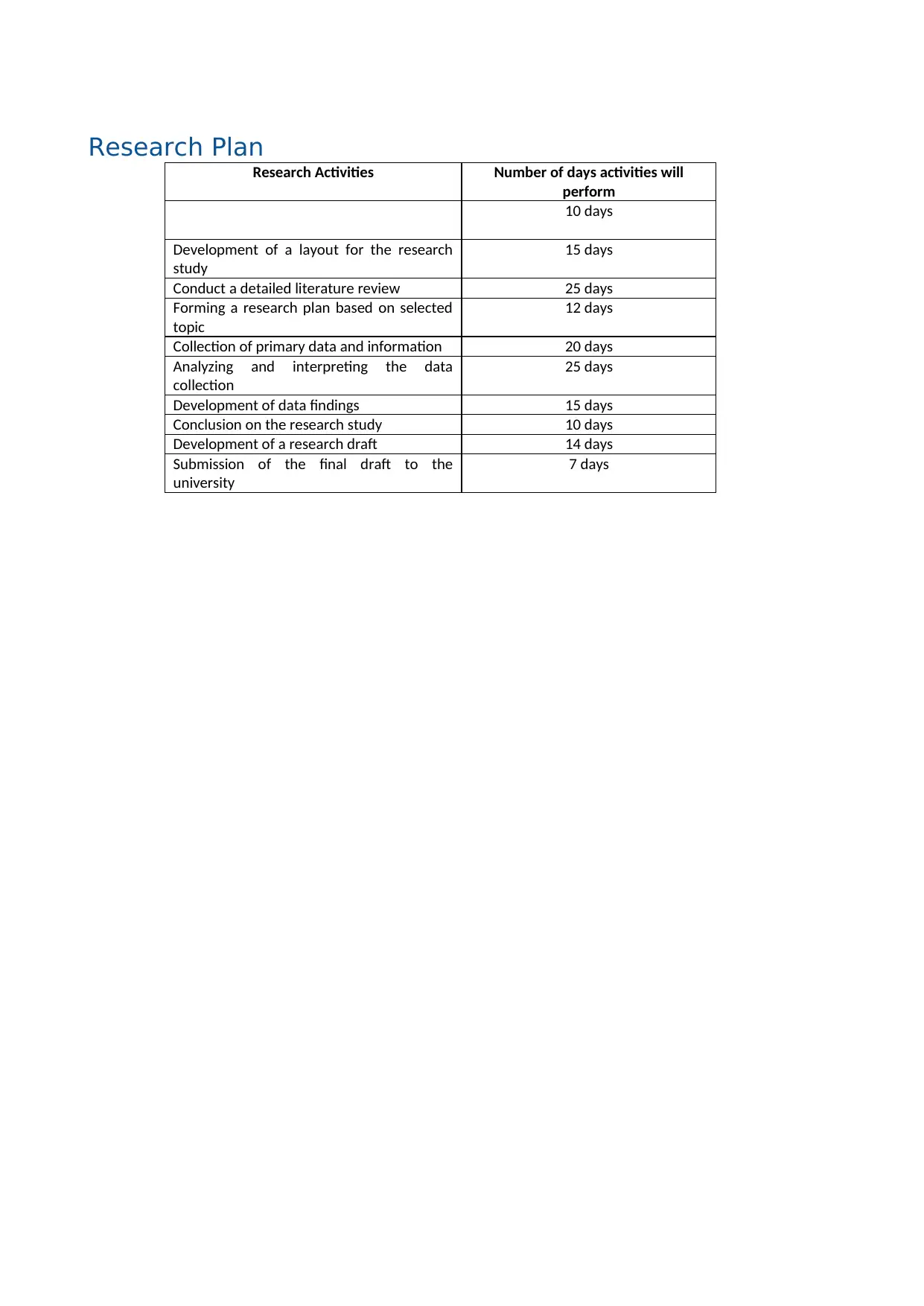
Research Plan
Research Activities Number of days activities will
perform
10 days
Development of a layout for the research
study
15 days
Conduct a detailed literature review 25 days
Forming a research plan based on selected
topic
12 days
Collection of primary data and information 20 days
Analyzing and interpreting the data
collection
25 days
Development of data findings 15 days
Conclusion on the research study 10 days
Development of a research draft 14 days
Submission of the final draft to the
university
7 days
Research Activities Number of days activities will
perform
10 days
Development of a layout for the research
study
15 days
Conduct a detailed literature review 25 days
Forming a research plan based on selected
topic
12 days
Collection of primary data and information 20 days
Analyzing and interpreting the data
collection
25 days
Development of data findings 15 days
Conclusion on the research study 10 days
Development of a research draft 14 days
Submission of the final draft to the
university
7 days
Paraphrase This Document
Need a fresh take? Get an instant paraphrase of this document with our AI Paraphraser
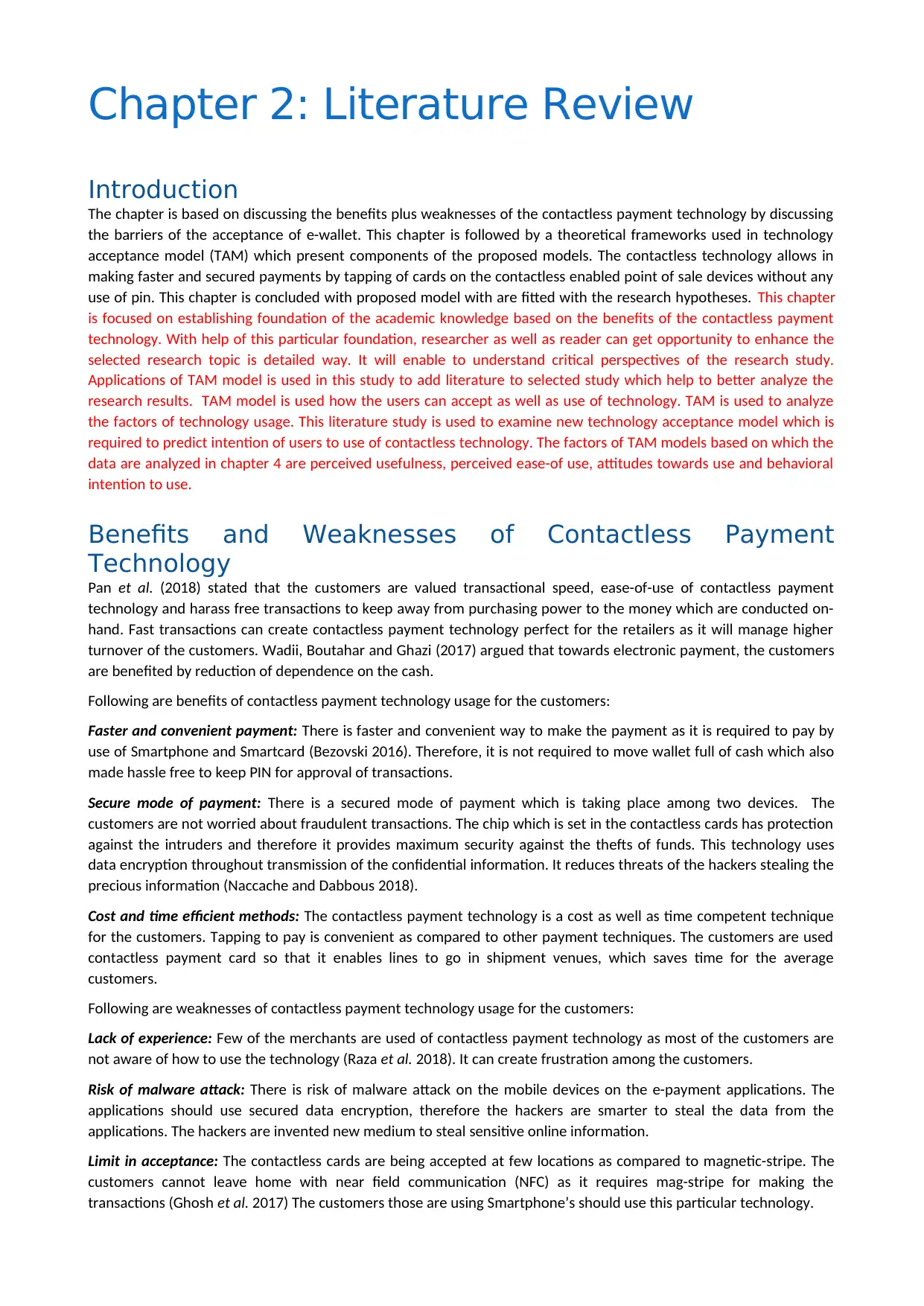
Chapter 2: Literature Review
Introduction
The chapter is based on discussing the benefits plus weaknesses of the contactless payment technology by discussing
the barriers of the acceptance of e-wallet. This chapter is followed by a theoretical frameworks used in technology
acceptance model (TAM) which present components of the proposed models. The contactless technology allows in
making faster and secured payments by tapping of cards on the contactless enabled point of sale devices without any
use of pin. This chapter is concluded with proposed model with are fitted with the research hypotheses. This chapter
is focused on establishing foundation of the academic knowledge based on the benefits of the contactless payment
technology. With help of this particular foundation, researcher as well as reader can get opportunity to enhance the
selected research topic is detailed way. It will enable to understand critical perspectives of the research study.
Applications of TAM model is used in this study to add literature to selected study which help to better analyze the
research results. TAM model is used how the users can accept as well as use of technology. TAM is used to analyze
the factors of technology usage. This literature study is used to examine new technology acceptance model which is
required to predict intention of users to use of contactless technology. The factors of TAM models based on which the
data are analyzed in chapter 4 are perceived usefulness, perceived ease-of use, attitudes towards use and behavioral
intention to use.
Benefits and Weaknesses of Contactless Payment
Technology
Pan et al. (2018) stated that the customers are valued transactional speed, ease-of-use of contactless payment
technology and harass free transactions to keep away from purchasing power to the money which are conducted on-
hand. Fast transactions can create contactless payment technology perfect for the retailers as it will manage higher
turnover of the customers. Wadii, Boutahar and Ghazi (2017) argued that towards electronic payment, the customers
are benefited by reduction of dependence on the cash.
Following are benefits of contactless payment technology usage for the customers:
Faster and convenient payment: There is faster and convenient way to make the payment as it is required to pay by
use of Smartphone and Smartcard (Bezovski 2016). Therefore, it is not required to move wallet full of cash which also
made hassle free to keep PIN for approval of transactions.
Secure mode of payment: There is a secured mode of payment which is taking place among two devices. The
customers are not worried about fraudulent transactions. The chip which is set in the contactless cards has protection
against the intruders and therefore it provides maximum security against the thefts of funds. This technology uses
data encryption throughout transmission of the confidential information. It reduces threats of the hackers stealing the
precious information (Naccache and Dabbous 2018).
Cost and time efficient methods: The contactless payment technology is a cost as well as time competent technique
for the customers. Tapping to pay is convenient as compared to other payment techniques. The customers are used
contactless payment card so that it enables lines to go in shipment venues, which saves time for the average
customers.
Following are weaknesses of contactless payment technology usage for the customers:
Lack of experience: Few of the merchants are used of contactless payment technology as most of the customers are
not aware of how to use the technology (Raza et al. 2018). It can create frustration among the customers.
Risk of malware attack: There is risk of malware attack on the mobile devices on the e-payment applications. The
applications should use secured data encryption, therefore the hackers are smarter to steal the data from the
applications. The hackers are invented new medium to steal sensitive online information.
Limit in acceptance: The contactless cards are being accepted at few locations as compared to magnetic-stripe. The
customers cannot leave home with near field communication (NFC) as it requires mag-stripe for making the
transactions (Ghosh et al. 2017) The customers those are using Smartphone’s should use this particular technology.
Introduction
The chapter is based on discussing the benefits plus weaknesses of the contactless payment technology by discussing
the barriers of the acceptance of e-wallet. This chapter is followed by a theoretical frameworks used in technology
acceptance model (TAM) which present components of the proposed models. The contactless technology allows in
making faster and secured payments by tapping of cards on the contactless enabled point of sale devices without any
use of pin. This chapter is concluded with proposed model with are fitted with the research hypotheses. This chapter
is focused on establishing foundation of the academic knowledge based on the benefits of the contactless payment
technology. With help of this particular foundation, researcher as well as reader can get opportunity to enhance the
selected research topic is detailed way. It will enable to understand critical perspectives of the research study.
Applications of TAM model is used in this study to add literature to selected study which help to better analyze the
research results. TAM model is used how the users can accept as well as use of technology. TAM is used to analyze
the factors of technology usage. This literature study is used to examine new technology acceptance model which is
required to predict intention of users to use of contactless technology. The factors of TAM models based on which the
data are analyzed in chapter 4 are perceived usefulness, perceived ease-of use, attitudes towards use and behavioral
intention to use.
Benefits and Weaknesses of Contactless Payment
Technology
Pan et al. (2018) stated that the customers are valued transactional speed, ease-of-use of contactless payment
technology and harass free transactions to keep away from purchasing power to the money which are conducted on-
hand. Fast transactions can create contactless payment technology perfect for the retailers as it will manage higher
turnover of the customers. Wadii, Boutahar and Ghazi (2017) argued that towards electronic payment, the customers
are benefited by reduction of dependence on the cash.
Following are benefits of contactless payment technology usage for the customers:
Faster and convenient payment: There is faster and convenient way to make the payment as it is required to pay by
use of Smartphone and Smartcard (Bezovski 2016). Therefore, it is not required to move wallet full of cash which also
made hassle free to keep PIN for approval of transactions.
Secure mode of payment: There is a secured mode of payment which is taking place among two devices. The
customers are not worried about fraudulent transactions. The chip which is set in the contactless cards has protection
against the intruders and therefore it provides maximum security against the thefts of funds. This technology uses
data encryption throughout transmission of the confidential information. It reduces threats of the hackers stealing the
precious information (Naccache and Dabbous 2018).
Cost and time efficient methods: The contactless payment technology is a cost as well as time competent technique
for the customers. Tapping to pay is convenient as compared to other payment techniques. The customers are used
contactless payment card so that it enables lines to go in shipment venues, which saves time for the average
customers.
Following are weaknesses of contactless payment technology usage for the customers:
Lack of experience: Few of the merchants are used of contactless payment technology as most of the customers are
not aware of how to use the technology (Raza et al. 2018). It can create frustration among the customers.
Risk of malware attack: There is risk of malware attack on the mobile devices on the e-payment applications. The
applications should use secured data encryption, therefore the hackers are smarter to steal the data from the
applications. The hackers are invented new medium to steal sensitive online information.
Limit in acceptance: The contactless cards are being accepted at few locations as compared to magnetic-stripe. The
customers cannot leave home with near field communication (NFC) as it requires mag-stripe for making the
transactions (Ghosh et al. 2017) The customers those are using Smartphone’s should use this particular technology.
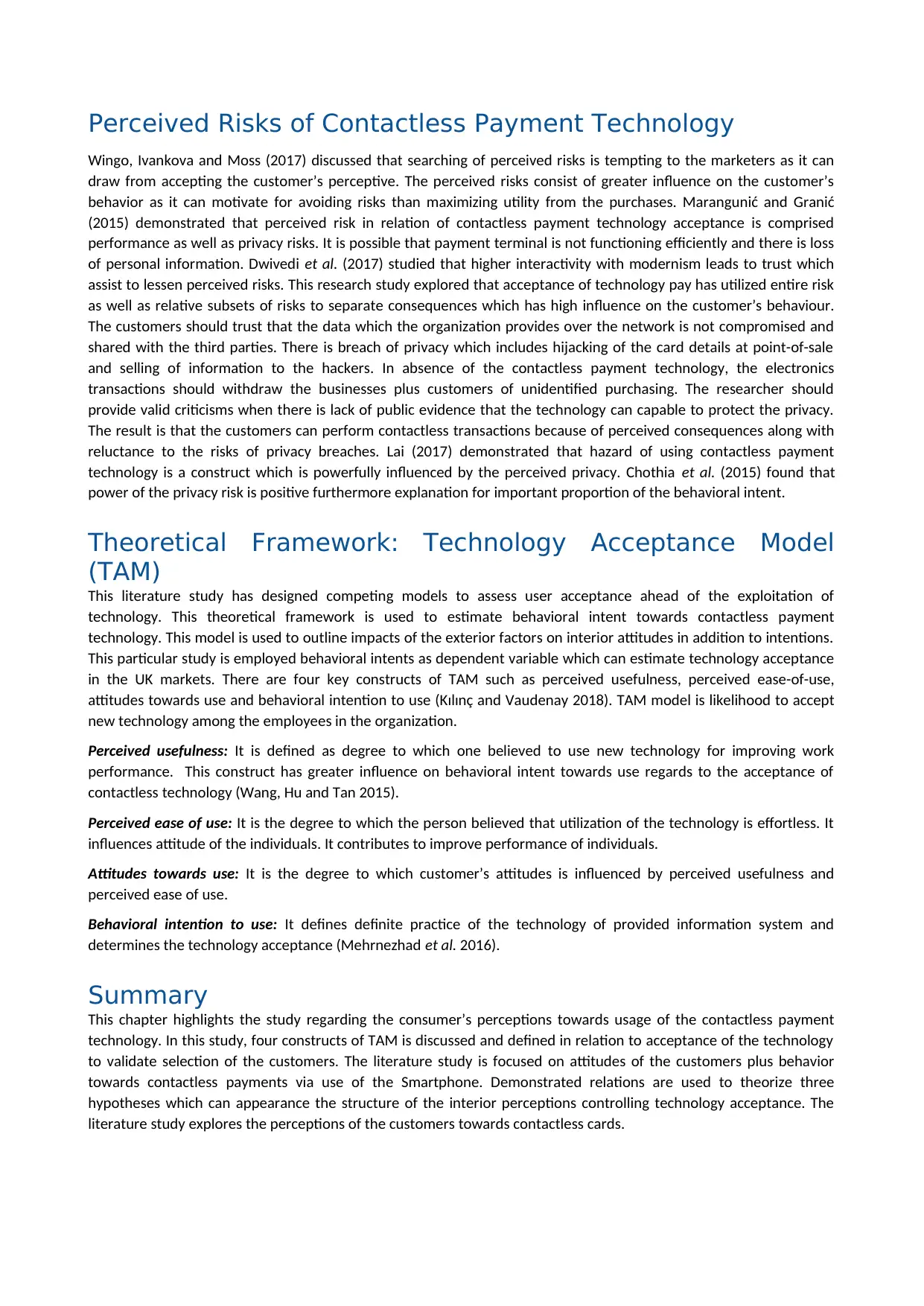
Perceived Risks of Contactless Payment Technology
Wingo, Ivankova and Moss (2017) discussed that searching of perceived risks is tempting to the marketers as it can
draw from accepting the customer’s perceptive. The perceived risks consist of greater influence on the customer’s
behavior as it can motivate for avoiding risks than maximizing utility from the purchases. Marangunić and Granić
(2015) demonstrated that perceived risk in relation of contactless payment technology acceptance is comprised
performance as well as privacy risks. It is possible that payment terminal is not functioning efficiently and there is loss
of personal information. Dwivedi et al. (2017) studied that higher interactivity with modernism leads to trust which
assist to lessen perceived risks. This research study explored that acceptance of technology pay has utilized entire risk
as well as relative subsets of risks to separate consequences which has high influence on the customer’s behaviour.
The customers should trust that the data which the organization provides over the network is not compromised and
shared with the third parties. There is breach of privacy which includes hijacking of the card details at point-of-sale
and selling of information to the hackers. In absence of the contactless payment technology, the electronics
transactions should withdraw the businesses plus customers of unidentified purchasing. The researcher should
provide valid criticisms when there is lack of public evidence that the technology can capable to protect the privacy.
The result is that the customers can perform contactless transactions because of perceived consequences along with
reluctance to the risks of privacy breaches. Lai (2017) demonstrated that hazard of using contactless payment
technology is a construct which is powerfully influenced by the perceived privacy. Chothia et al. (2015) found that
power of the privacy risk is positive furthermore explanation for important proportion of the behavioral intent.
Theoretical Framework: Technology Acceptance Model
(TAM)
This literature study has designed competing models to assess user acceptance ahead of the exploitation of
technology. This theoretical framework is used to estimate behavioral intent towards contactless payment
technology. This model is used to outline impacts of the exterior factors on interior attitudes in addition to intentions.
This particular study is employed behavioral intents as dependent variable which can estimate technology acceptance
in the UK markets. There are four key constructs of TAM such as perceived usefulness, perceived ease-of-use,
attitudes towards use and behavioral intention to use (Kılınç and Vaudenay 2018). TAM model is likelihood to accept
new technology among the employees in the organization.
Perceived usefulness: It is defined as degree to which one believed to use new technology for improving work
performance. This construct has greater influence on behavioral intent towards use regards to the acceptance of
contactless technology (Wang, Hu and Tan 2015).
Perceived ease of use: It is the degree to which the person believed that utilization of the technology is effortless. It
influences attitude of the individuals. It contributes to improve performance of individuals.
Attitudes towards use: It is the degree to which customer’s attitudes is influenced by perceived usefulness and
perceived ease of use.
Behavioral intention to use: It defines definite practice of the technology of provided information system and
determines the technology acceptance (Mehrnezhad et al. 2016).
Summary
This chapter highlights the study regarding the consumer’s perceptions towards usage of the contactless payment
technology. In this study, four constructs of TAM is discussed and defined in relation to acceptance of the technology
to validate selection of the customers. The literature study is focused on attitudes of the customers plus behavior
towards contactless payments via use of the Smartphone. Demonstrated relations are used to theorize three
hypotheses which can appearance the structure of the interior perceptions controlling technology acceptance. The
literature study explores the perceptions of the customers towards contactless cards.
Wingo, Ivankova and Moss (2017) discussed that searching of perceived risks is tempting to the marketers as it can
draw from accepting the customer’s perceptive. The perceived risks consist of greater influence on the customer’s
behavior as it can motivate for avoiding risks than maximizing utility from the purchases. Marangunić and Granić
(2015) demonstrated that perceived risk in relation of contactless payment technology acceptance is comprised
performance as well as privacy risks. It is possible that payment terminal is not functioning efficiently and there is loss
of personal information. Dwivedi et al. (2017) studied that higher interactivity with modernism leads to trust which
assist to lessen perceived risks. This research study explored that acceptance of technology pay has utilized entire risk
as well as relative subsets of risks to separate consequences which has high influence on the customer’s behaviour.
The customers should trust that the data which the organization provides over the network is not compromised and
shared with the third parties. There is breach of privacy which includes hijacking of the card details at point-of-sale
and selling of information to the hackers. In absence of the contactless payment technology, the electronics
transactions should withdraw the businesses plus customers of unidentified purchasing. The researcher should
provide valid criticisms when there is lack of public evidence that the technology can capable to protect the privacy.
The result is that the customers can perform contactless transactions because of perceived consequences along with
reluctance to the risks of privacy breaches. Lai (2017) demonstrated that hazard of using contactless payment
technology is a construct which is powerfully influenced by the perceived privacy. Chothia et al. (2015) found that
power of the privacy risk is positive furthermore explanation for important proportion of the behavioral intent.
Theoretical Framework: Technology Acceptance Model
(TAM)
This literature study has designed competing models to assess user acceptance ahead of the exploitation of
technology. This theoretical framework is used to estimate behavioral intent towards contactless payment
technology. This model is used to outline impacts of the exterior factors on interior attitudes in addition to intentions.
This particular study is employed behavioral intents as dependent variable which can estimate technology acceptance
in the UK markets. There are four key constructs of TAM such as perceived usefulness, perceived ease-of-use,
attitudes towards use and behavioral intention to use (Kılınç and Vaudenay 2018). TAM model is likelihood to accept
new technology among the employees in the organization.
Perceived usefulness: It is defined as degree to which one believed to use new technology for improving work
performance. This construct has greater influence on behavioral intent towards use regards to the acceptance of
contactless technology (Wang, Hu and Tan 2015).
Perceived ease of use: It is the degree to which the person believed that utilization of the technology is effortless. It
influences attitude of the individuals. It contributes to improve performance of individuals.
Attitudes towards use: It is the degree to which customer’s attitudes is influenced by perceived usefulness and
perceived ease of use.
Behavioral intention to use: It defines definite practice of the technology of provided information system and
determines the technology acceptance (Mehrnezhad et al. 2016).
Summary
This chapter highlights the study regarding the consumer’s perceptions towards usage of the contactless payment
technology. In this study, four constructs of TAM is discussed and defined in relation to acceptance of the technology
to validate selection of the customers. The literature study is focused on attitudes of the customers plus behavior
towards contactless payments via use of the Smartphone. Demonstrated relations are used to theorize three
hypotheses which can appearance the structure of the interior perceptions controlling technology acceptance. The
literature study explores the perceptions of the customers towards contactless cards.
⊘ This is a preview!⊘
Do you want full access?
Subscribe today to unlock all pages.

Trusted by 1+ million students worldwide
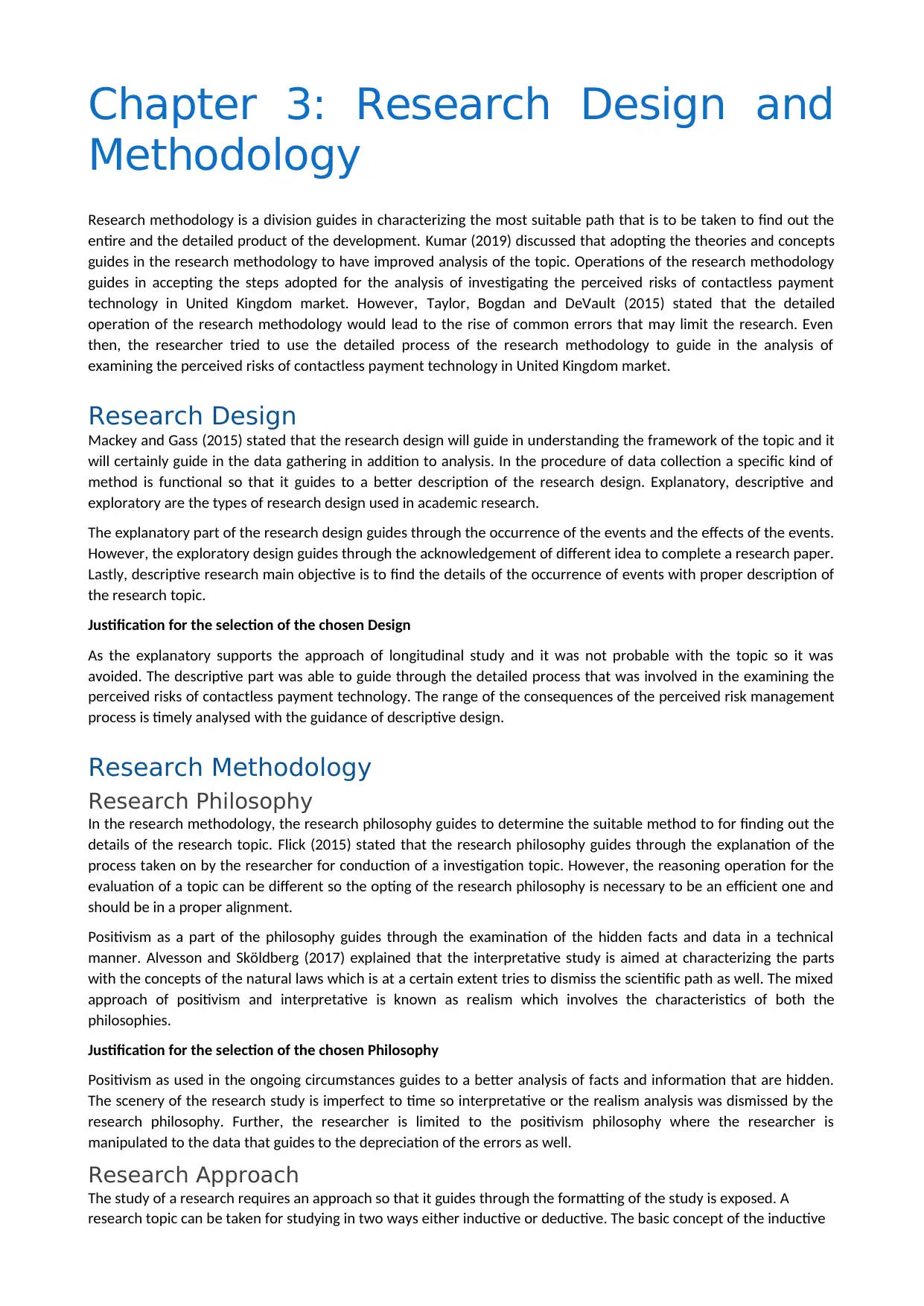
Chapter 3: Research Design and
Methodology
Research methodology is a division guides in characterizing the most suitable path that is to be taken to find out the
entire and the detailed product of the development. Kumar (2019) discussed that adopting the theories and concepts
guides in the research methodology to have improved analysis of the topic. Operations of the research methodology
guides in accepting the steps adopted for the analysis of investigating the perceived risks of contactless payment
technology in United Kingdom market. However, Taylor, Bogdan and DeVault (2015) stated that the detailed
operation of the research methodology would lead to the rise of common errors that may limit the research. Even
then, the researcher tried to use the detailed process of the research methodology to guide in the analysis of
examining the perceived risks of contactless payment technology in United Kingdom market.
Research Design
Mackey and Gass (2015) stated that the research design will guide in understanding the framework of the topic and it
will certainly guide in the data gathering in addition to analysis. In the procedure of data collection a specific kind of
method is functional so that it guides to a better description of the research design. Explanatory, descriptive and
exploratory are the types of research design used in academic research.
The explanatory part of the research design guides through the occurrence of the events and the effects of the events.
However, the exploratory design guides through the acknowledgement of different idea to complete a research paper.
Lastly, descriptive research main objective is to find the details of the occurrence of events with proper description of
the research topic.
Justification for the selection of the chosen Design
As the explanatory supports the approach of longitudinal study and it was not probable with the topic so it was
avoided. The descriptive part was able to guide through the detailed process that was involved in the examining the
perceived risks of contactless payment technology. The range of the consequences of the perceived risk management
process is timely analysed with the guidance of descriptive design.
Research Methodology
Research Philosophy
In the research methodology, the research philosophy guides to determine the suitable method to for finding out the
details of the research topic. Flick (2015) stated that the research philosophy guides through the explanation of the
process taken on by the researcher for conduction of a investigation topic. However, the reasoning operation for the
evaluation of a topic can be different so the opting of the research philosophy is necessary to be an efficient one and
should be in a proper alignment.
Positivism as a part of the philosophy guides through the examination of the hidden facts and data in a technical
manner. Alvesson and Sköldberg (2017) explained that the interpretative study is aimed at characterizing the parts
with the concepts of the natural laws which is at a certain extent tries to dismiss the scientific path as well. The mixed
approach of positivism and interpretative is known as realism which involves the characteristics of both the
philosophies.
Justification for the selection of the chosen Philosophy
Positivism as used in the ongoing circumstances guides to a better analysis of facts and information that are hidden.
The scenery of the research study is imperfect to time so interpretative or the realism analysis was dismissed by the
research philosophy. Further, the researcher is limited to the positivism philosophy where the researcher is
manipulated to the data that guides to the depreciation of the errors as well.
Research Approach
The study of a research requires an approach so that it guides through the formatting of the study is exposed. A
research topic can be taken for studying in two ways either inductive or deductive. The basic concept of the inductive
Methodology
Research methodology is a division guides in characterizing the most suitable path that is to be taken to find out the
entire and the detailed product of the development. Kumar (2019) discussed that adopting the theories and concepts
guides in the research methodology to have improved analysis of the topic. Operations of the research methodology
guides in accepting the steps adopted for the analysis of investigating the perceived risks of contactless payment
technology in United Kingdom market. However, Taylor, Bogdan and DeVault (2015) stated that the detailed
operation of the research methodology would lead to the rise of common errors that may limit the research. Even
then, the researcher tried to use the detailed process of the research methodology to guide in the analysis of
examining the perceived risks of contactless payment technology in United Kingdom market.
Research Design
Mackey and Gass (2015) stated that the research design will guide in understanding the framework of the topic and it
will certainly guide in the data gathering in addition to analysis. In the procedure of data collection a specific kind of
method is functional so that it guides to a better description of the research design. Explanatory, descriptive and
exploratory are the types of research design used in academic research.
The explanatory part of the research design guides through the occurrence of the events and the effects of the events.
However, the exploratory design guides through the acknowledgement of different idea to complete a research paper.
Lastly, descriptive research main objective is to find the details of the occurrence of events with proper description of
the research topic.
Justification for the selection of the chosen Design
As the explanatory supports the approach of longitudinal study and it was not probable with the topic so it was
avoided. The descriptive part was able to guide through the detailed process that was involved in the examining the
perceived risks of contactless payment technology. The range of the consequences of the perceived risk management
process is timely analysed with the guidance of descriptive design.
Research Methodology
Research Philosophy
In the research methodology, the research philosophy guides to determine the suitable method to for finding out the
details of the research topic. Flick (2015) stated that the research philosophy guides through the explanation of the
process taken on by the researcher for conduction of a investigation topic. However, the reasoning operation for the
evaluation of a topic can be different so the opting of the research philosophy is necessary to be an efficient one and
should be in a proper alignment.
Positivism as a part of the philosophy guides through the examination of the hidden facts and data in a technical
manner. Alvesson and Sköldberg (2017) explained that the interpretative study is aimed at characterizing the parts
with the concepts of the natural laws which is at a certain extent tries to dismiss the scientific path as well. The mixed
approach of positivism and interpretative is known as realism which involves the characteristics of both the
philosophies.
Justification for the selection of the chosen Philosophy
Positivism as used in the ongoing circumstances guides to a better analysis of facts and information that are hidden.
The scenery of the research study is imperfect to time so interpretative or the realism analysis was dismissed by the
research philosophy. Further, the researcher is limited to the positivism philosophy where the researcher is
manipulated to the data that guides to the depreciation of the errors as well.
Research Approach
The study of a research requires an approach so that it guides through the formatting of the study is exposed. A
research topic can be taken for studying in two ways either inductive or deductive. The basic concept of the inductive
Paraphrase This Document
Need a fresh take? Get an instant paraphrase of this document with our AI Paraphraser
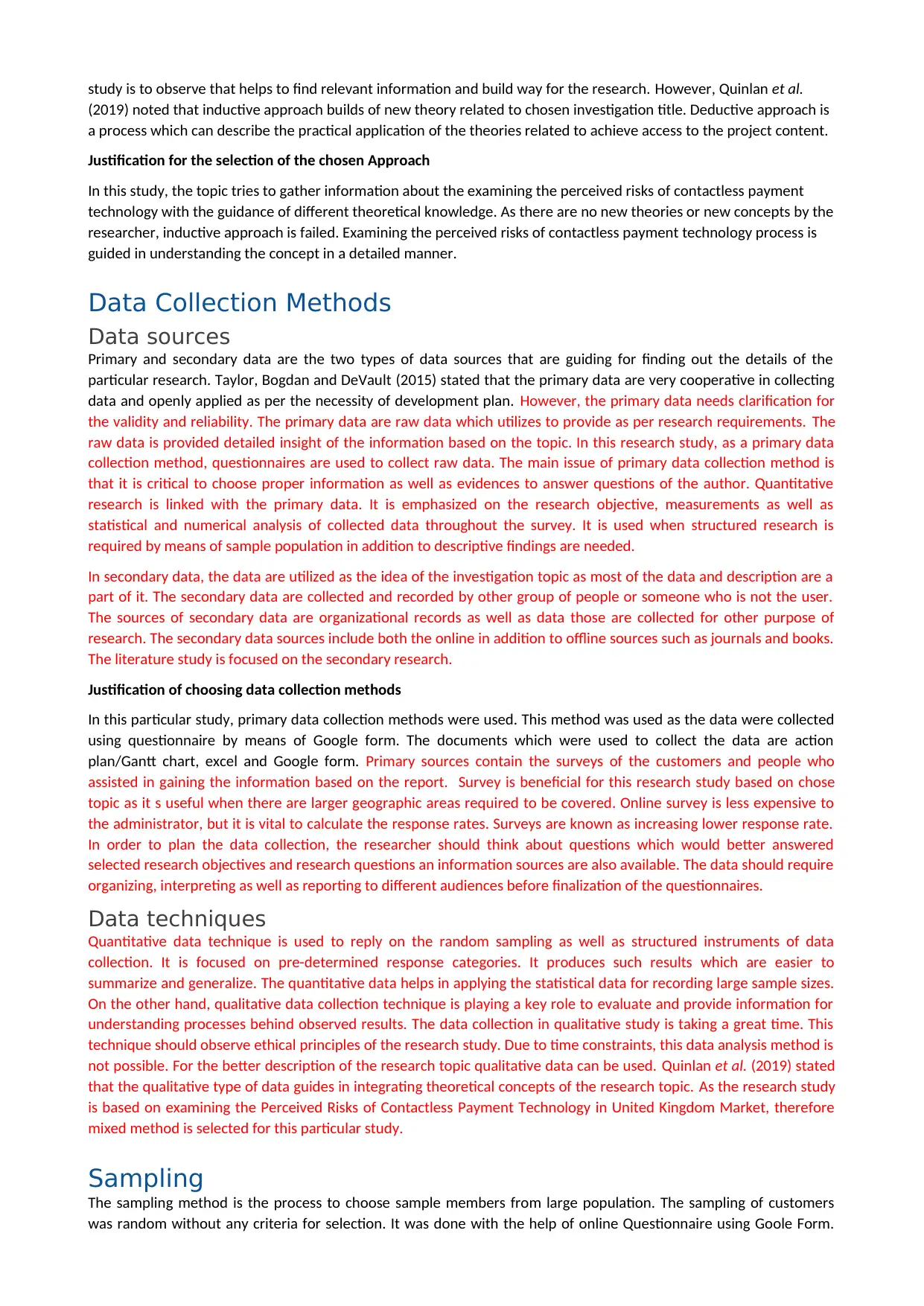
study is to observe that helps to find relevant information and build way for the research. However, Quinlan et al.
(2019) noted that inductive approach builds of new theory related to chosen investigation title. Deductive approach is
a process which can describe the practical application of the theories related to achieve access to the project content.
Justification for the selection of the chosen Approach
In this study, the topic tries to gather information about the examining the perceived risks of contactless payment
technology with the guidance of different theoretical knowledge. As there are no new theories or new concepts by the
researcher, inductive approach is failed. Examining the perceived risks of contactless payment technology process is
guided in understanding the concept in a detailed manner.
Data Collection Methods
Data sources
Primary and secondary data are the two types of data sources that are guiding for finding out the details of the
particular research. Taylor, Bogdan and DeVault (2015) stated that the primary data are very cooperative in collecting
data and openly applied as per the necessity of development plan. However, the primary data needs clarification for
the validity and reliability. The primary data are raw data which utilizes to provide as per research requirements. The
raw data is provided detailed insight of the information based on the topic. In this research study, as a primary data
collection method, questionnaires are used to collect raw data. The main issue of primary data collection method is
that it is critical to choose proper information as well as evidences to answer questions of the author. Quantitative
research is linked with the primary data. It is emphasized on the research objective, measurements as well as
statistical and numerical analysis of collected data throughout the survey. It is used when structured research is
required by means of sample population in addition to descriptive findings are needed.
In secondary data, the data are utilized as the idea of the investigation topic as most of the data and description are a
part of it. The secondary data are collected and recorded by other group of people or someone who is not the user.
The sources of secondary data are organizational records as well as data those are collected for other purpose of
research. The secondary data sources include both the online in addition to offline sources such as journals and books.
The literature study is focused on the secondary research.
Justification of choosing data collection methods
In this particular study, primary data collection methods were used. This method was used as the data were collected
using questionnaire by means of Google form. The documents which were used to collect the data are action
plan/Gantt chart, excel and Google form. Primary sources contain the surveys of the customers and people who
assisted in gaining the information based on the report. Survey is beneficial for this research study based on chose
topic as it s useful when there are larger geographic areas required to be covered. Online survey is less expensive to
the administrator, but it is vital to calculate the response rates. Surveys are known as increasing lower response rate.
In order to plan the data collection, the researcher should think about questions which would better answered
selected research objectives and research questions an information sources are also available. The data should require
organizing, interpreting as well as reporting to different audiences before finalization of the questionnaires.
Data techniques
Quantitative data technique is used to reply on the random sampling as well as structured instruments of data
collection. It is focused on pre-determined response categories. It produces such results which are easier to
summarize and generalize. The quantitative data helps in applying the statistical data for recording large sample sizes.
On the other hand, qualitative data collection technique is playing a key role to evaluate and provide information for
understanding processes behind observed results. The data collection in qualitative study is taking a great time. This
technique should observe ethical principles of the research study. Due to time constraints, this data analysis method is
not possible. For the better description of the research topic qualitative data can be used. Quinlan et al. (2019) stated
that the qualitative type of data guides in integrating theoretical concepts of the research topic. As the research study
is based on examining the Perceived Risks of Contactless Payment Technology in United Kingdom Market, therefore
mixed method is selected for this particular study.
Sampling
The sampling method is the process to choose sample members from large population. The sampling of customers
was random without any criteria for selection. It was done with the help of online Questionnaire using Goole Form.
(2019) noted that inductive approach builds of new theory related to chosen investigation title. Deductive approach is
a process which can describe the practical application of the theories related to achieve access to the project content.
Justification for the selection of the chosen Approach
In this study, the topic tries to gather information about the examining the perceived risks of contactless payment
technology with the guidance of different theoretical knowledge. As there are no new theories or new concepts by the
researcher, inductive approach is failed. Examining the perceived risks of contactless payment technology process is
guided in understanding the concept in a detailed manner.
Data Collection Methods
Data sources
Primary and secondary data are the two types of data sources that are guiding for finding out the details of the
particular research. Taylor, Bogdan and DeVault (2015) stated that the primary data are very cooperative in collecting
data and openly applied as per the necessity of development plan. However, the primary data needs clarification for
the validity and reliability. The primary data are raw data which utilizes to provide as per research requirements. The
raw data is provided detailed insight of the information based on the topic. In this research study, as a primary data
collection method, questionnaires are used to collect raw data. The main issue of primary data collection method is
that it is critical to choose proper information as well as evidences to answer questions of the author. Quantitative
research is linked with the primary data. It is emphasized on the research objective, measurements as well as
statistical and numerical analysis of collected data throughout the survey. It is used when structured research is
required by means of sample population in addition to descriptive findings are needed.
In secondary data, the data are utilized as the idea of the investigation topic as most of the data and description are a
part of it. The secondary data are collected and recorded by other group of people or someone who is not the user.
The sources of secondary data are organizational records as well as data those are collected for other purpose of
research. The secondary data sources include both the online in addition to offline sources such as journals and books.
The literature study is focused on the secondary research.
Justification of choosing data collection methods
In this particular study, primary data collection methods were used. This method was used as the data were collected
using questionnaire by means of Google form. The documents which were used to collect the data are action
plan/Gantt chart, excel and Google form. Primary sources contain the surveys of the customers and people who
assisted in gaining the information based on the report. Survey is beneficial for this research study based on chose
topic as it s useful when there are larger geographic areas required to be covered. Online survey is less expensive to
the administrator, but it is vital to calculate the response rates. Surveys are known as increasing lower response rate.
In order to plan the data collection, the researcher should think about questions which would better answered
selected research objectives and research questions an information sources are also available. The data should require
organizing, interpreting as well as reporting to different audiences before finalization of the questionnaires.
Data techniques
Quantitative data technique is used to reply on the random sampling as well as structured instruments of data
collection. It is focused on pre-determined response categories. It produces such results which are easier to
summarize and generalize. The quantitative data helps in applying the statistical data for recording large sample sizes.
On the other hand, qualitative data collection technique is playing a key role to evaluate and provide information for
understanding processes behind observed results. The data collection in qualitative study is taking a great time. This
technique should observe ethical principles of the research study. Due to time constraints, this data analysis method is
not possible. For the better description of the research topic qualitative data can be used. Quinlan et al. (2019) stated
that the qualitative type of data guides in integrating theoretical concepts of the research topic. As the research study
is based on examining the Perceived Risks of Contactless Payment Technology in United Kingdom Market, therefore
mixed method is selected for this particular study.
Sampling
The sampling method is the process to choose sample members from large population. The sampling of customers
was random without any criteria for selection. It was done with the help of online Questionnaire using Goole Form.
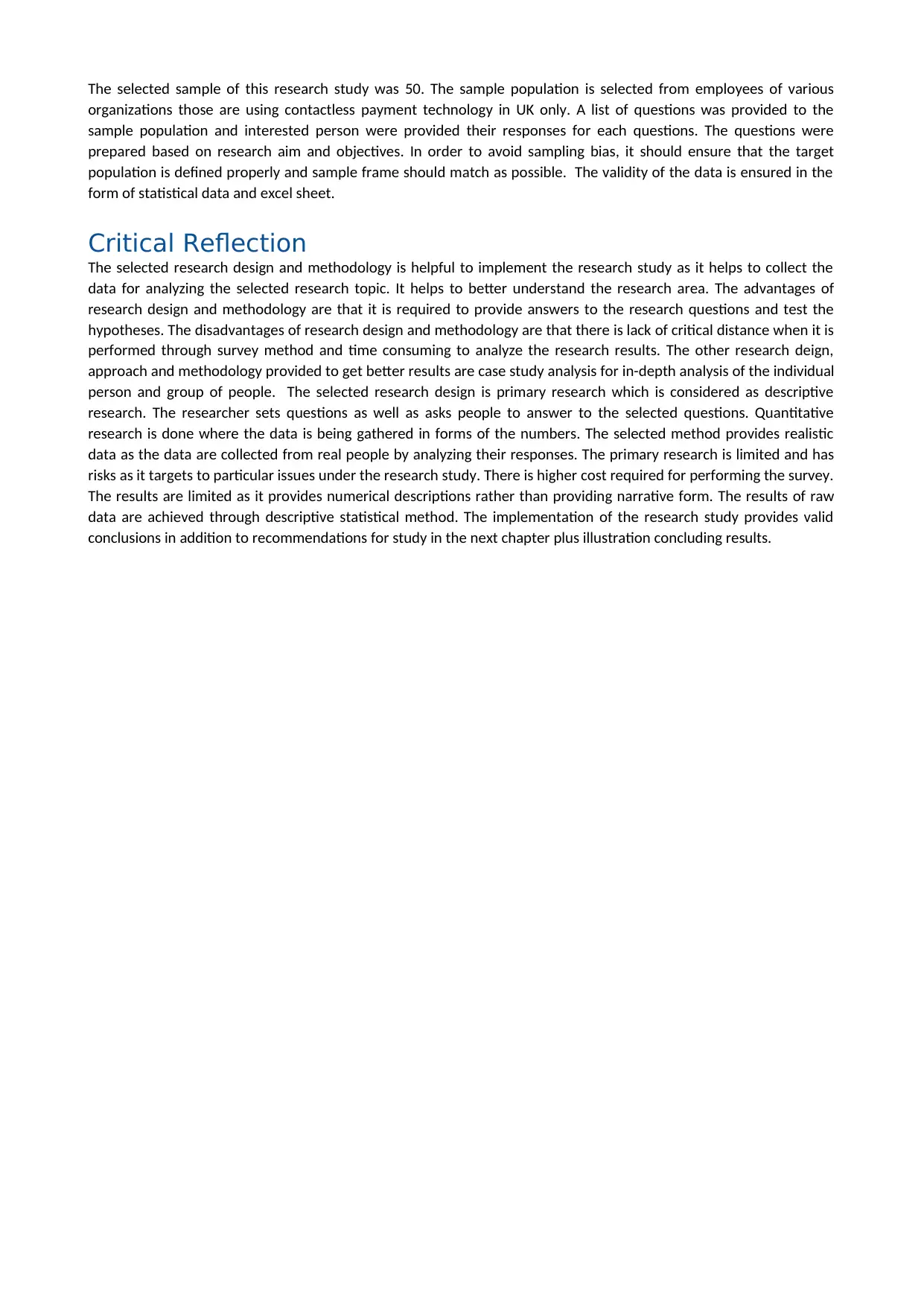
The selected sample of this research study was 50. The sample population is selected from employees of various
organizations those are using contactless payment technology in UK only. A list of questions was provided to the
sample population and interested person were provided their responses for each questions. The questions were
prepared based on research aim and objectives. In order to avoid sampling bias, it should ensure that the target
population is defined properly and sample frame should match as possible. The validity of the data is ensured in the
form of statistical data and excel sheet.
Critical Reflection
The selected research design and methodology is helpful to implement the research study as it helps to collect the
data for analyzing the selected research topic. It helps to better understand the research area. The advantages of
research design and methodology are that it is required to provide answers to the research questions and test the
hypotheses. The disadvantages of research design and methodology are that there is lack of critical distance when it is
performed through survey method and time consuming to analyze the research results. The other research deign,
approach and methodology provided to get better results are case study analysis for in-depth analysis of the individual
person and group of people. The selected research design is primary research which is considered as descriptive
research. The researcher sets questions as well as asks people to answer to the selected questions. Quantitative
research is done where the data is being gathered in forms of the numbers. The selected method provides realistic
data as the data are collected from real people by analyzing their responses. The primary research is limited and has
risks as it targets to particular issues under the research study. There is higher cost required for performing the survey.
The results are limited as it provides numerical descriptions rather than providing narrative form. The results of raw
data are achieved through descriptive statistical method. The implementation of the research study provides valid
conclusions in addition to recommendations for study in the next chapter plus illustration concluding results.
organizations those are using contactless payment technology in UK only. A list of questions was provided to the
sample population and interested person were provided their responses for each questions. The questions were
prepared based on research aim and objectives. In order to avoid sampling bias, it should ensure that the target
population is defined properly and sample frame should match as possible. The validity of the data is ensured in the
form of statistical data and excel sheet.
Critical Reflection
The selected research design and methodology is helpful to implement the research study as it helps to collect the
data for analyzing the selected research topic. It helps to better understand the research area. The advantages of
research design and methodology are that it is required to provide answers to the research questions and test the
hypotheses. The disadvantages of research design and methodology are that there is lack of critical distance when it is
performed through survey method and time consuming to analyze the research results. The other research deign,
approach and methodology provided to get better results are case study analysis for in-depth analysis of the individual
person and group of people. The selected research design is primary research which is considered as descriptive
research. The researcher sets questions as well as asks people to answer to the selected questions. Quantitative
research is done where the data is being gathered in forms of the numbers. The selected method provides realistic
data as the data are collected from real people by analyzing their responses. The primary research is limited and has
risks as it targets to particular issues under the research study. There is higher cost required for performing the survey.
The results are limited as it provides numerical descriptions rather than providing narrative form. The results of raw
data are achieved through descriptive statistical method. The implementation of the research study provides valid
conclusions in addition to recommendations for study in the next chapter plus illustration concluding results.
⊘ This is a preview!⊘
Do you want full access?
Subscribe today to unlock all pages.

Trusted by 1+ million students worldwide
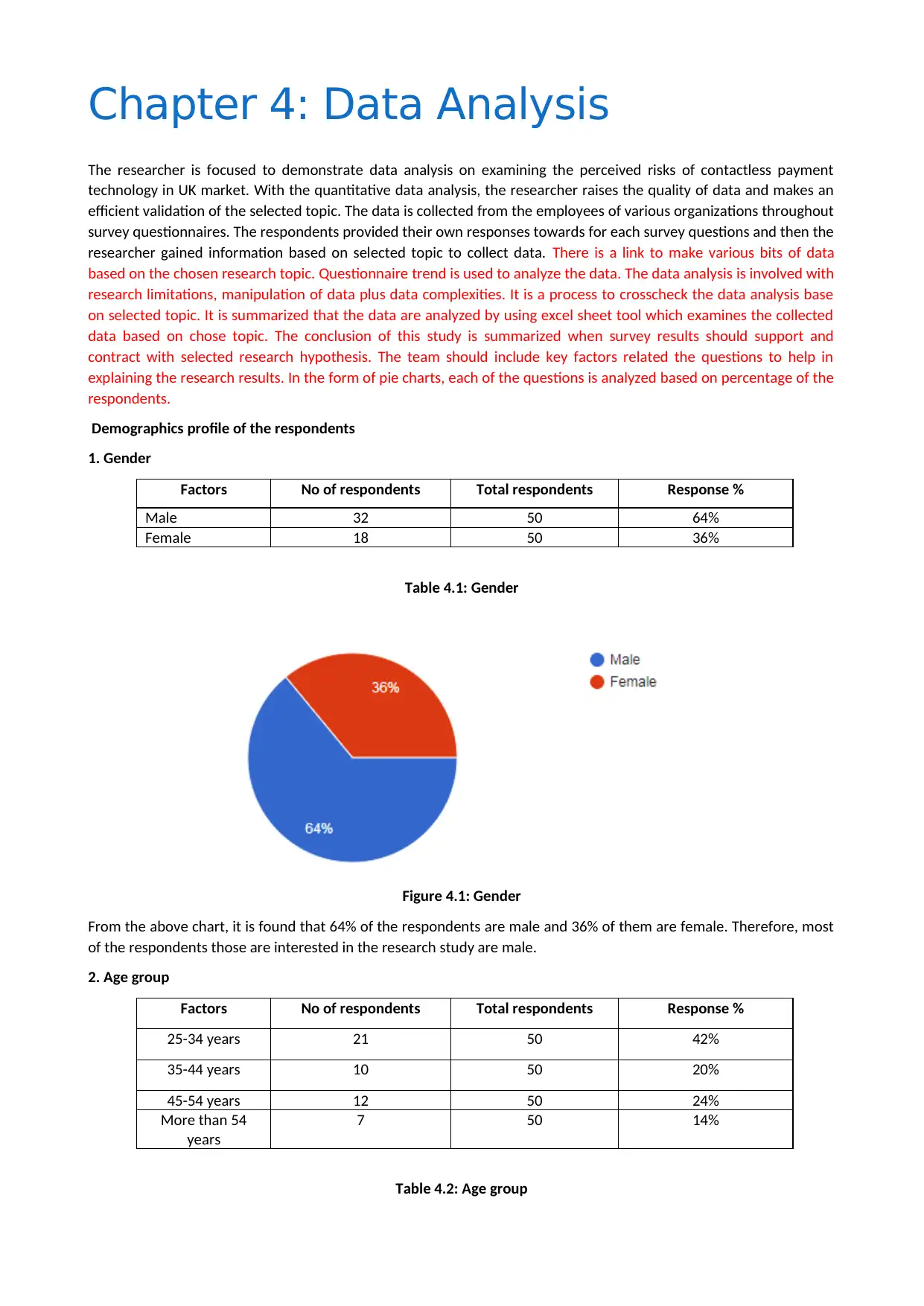
Chapter 4: Data Analysis
The researcher is focused to demonstrate data analysis on examining the perceived risks of contactless payment
technology in UK market. With the quantitative data analysis, the researcher raises the quality of data and makes an
efficient validation of the selected topic. The data is collected from the employees of various organizations throughout
survey questionnaires. The respondents provided their own responses towards for each survey questions and then the
researcher gained information based on selected topic to collect data. There is a link to make various bits of data
based on the chosen research topic. Questionnaire trend is used to analyze the data. The data analysis is involved with
research limitations, manipulation of data plus data complexities. It is a process to crosscheck the data analysis base
on selected topic. It is summarized that the data are analyzed by using excel sheet tool which examines the collected
data based on chose topic. The conclusion of this study is summarized when survey results should support and
contract with selected research hypothesis. The team should include key factors related the questions to help in
explaining the research results. In the form of pie charts, each of the questions is analyzed based on percentage of the
respondents.
Demographics profile of the respondents
1. Gender
Factors No of respondents Total respondents Response %
Male 32 50 64%
Female 18 50 36%
Table 4.1: Gender
Figure 4.1: Gender
From the above chart, it is found that 64% of the respondents are male and 36% of them are female. Therefore, most
of the respondents those are interested in the research study are male.
2. Age group
Factors No of respondents Total respondents Response %
25-34 years 21 50 42%
35-44 years 10 50 20%
45-54 years 12 50 24%
More than 54
years
7 50 14%
Table 4.2: Age group
The researcher is focused to demonstrate data analysis on examining the perceived risks of contactless payment
technology in UK market. With the quantitative data analysis, the researcher raises the quality of data and makes an
efficient validation of the selected topic. The data is collected from the employees of various organizations throughout
survey questionnaires. The respondents provided their own responses towards for each survey questions and then the
researcher gained information based on selected topic to collect data. There is a link to make various bits of data
based on the chosen research topic. Questionnaire trend is used to analyze the data. The data analysis is involved with
research limitations, manipulation of data plus data complexities. It is a process to crosscheck the data analysis base
on selected topic. It is summarized that the data are analyzed by using excel sheet tool which examines the collected
data based on chose topic. The conclusion of this study is summarized when survey results should support and
contract with selected research hypothesis. The team should include key factors related the questions to help in
explaining the research results. In the form of pie charts, each of the questions is analyzed based on percentage of the
respondents.
Demographics profile of the respondents
1. Gender
Factors No of respondents Total respondents Response %
Male 32 50 64%
Female 18 50 36%
Table 4.1: Gender
Figure 4.1: Gender
From the above chart, it is found that 64% of the respondents are male and 36% of them are female. Therefore, most
of the respondents those are interested in the research study are male.
2. Age group
Factors No of respondents Total respondents Response %
25-34 years 21 50 42%
35-44 years 10 50 20%
45-54 years 12 50 24%
More than 54
years
7 50 14%
Table 4.2: Age group
Paraphrase This Document
Need a fresh take? Get an instant paraphrase of this document with our AI Paraphraser
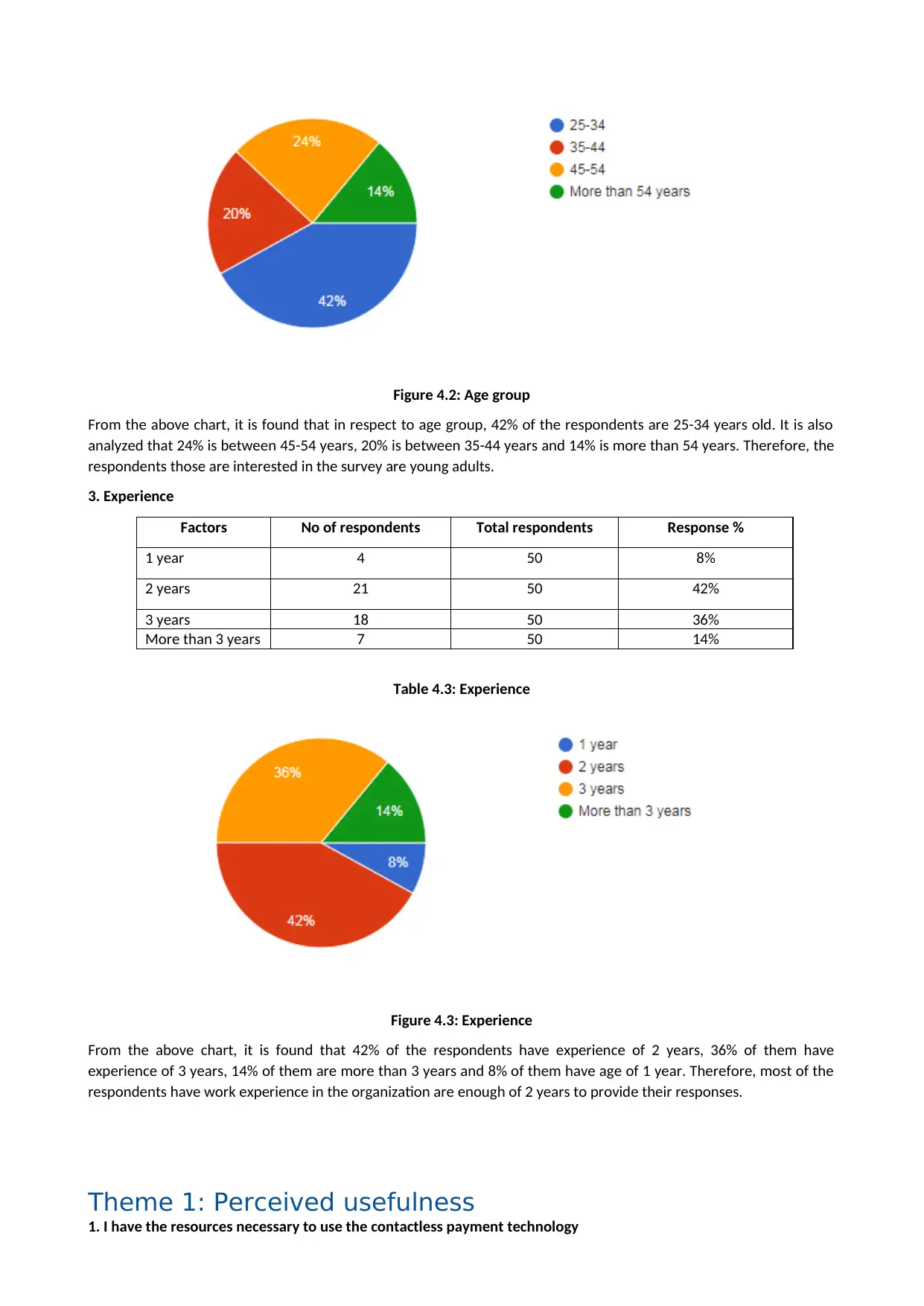
Figure 4.2: Age group
From the above chart, it is found that in respect to age group, 42% of the respondents are 25-34 years old. It is also
analyzed that 24% is between 45-54 years, 20% is between 35-44 years and 14% is more than 54 years. Therefore, the
respondents those are interested in the survey are young adults.
3. Experience
Factors No of respondents Total respondents Response %
1 year 4 50 8%
2 years 21 50 42%
3 years 18 50 36%
More than 3 years 7 50 14%
Table 4.3: Experience
Figure 4.3: Experience
From the above chart, it is found that 42% of the respondents have experience of 2 years, 36% of them have
experience of 3 years, 14% of them are more than 3 years and 8% of them have age of 1 year. Therefore, most of the
respondents have work experience in the organization are enough of 2 years to provide their responses.
Theme 1: Perceived usefulness
1. I have the resources necessary to use the contactless payment technology
From the above chart, it is found that in respect to age group, 42% of the respondents are 25-34 years old. It is also
analyzed that 24% is between 45-54 years, 20% is between 35-44 years and 14% is more than 54 years. Therefore, the
respondents those are interested in the survey are young adults.
3. Experience
Factors No of respondents Total respondents Response %
1 year 4 50 8%
2 years 21 50 42%
3 years 18 50 36%
More than 3 years 7 50 14%
Table 4.3: Experience
Figure 4.3: Experience
From the above chart, it is found that 42% of the respondents have experience of 2 years, 36% of them have
experience of 3 years, 14% of them are more than 3 years and 8% of them have age of 1 year. Therefore, most of the
respondents have work experience in the organization are enough of 2 years to provide their responses.
Theme 1: Perceived usefulness
1. I have the resources necessary to use the contactless payment technology
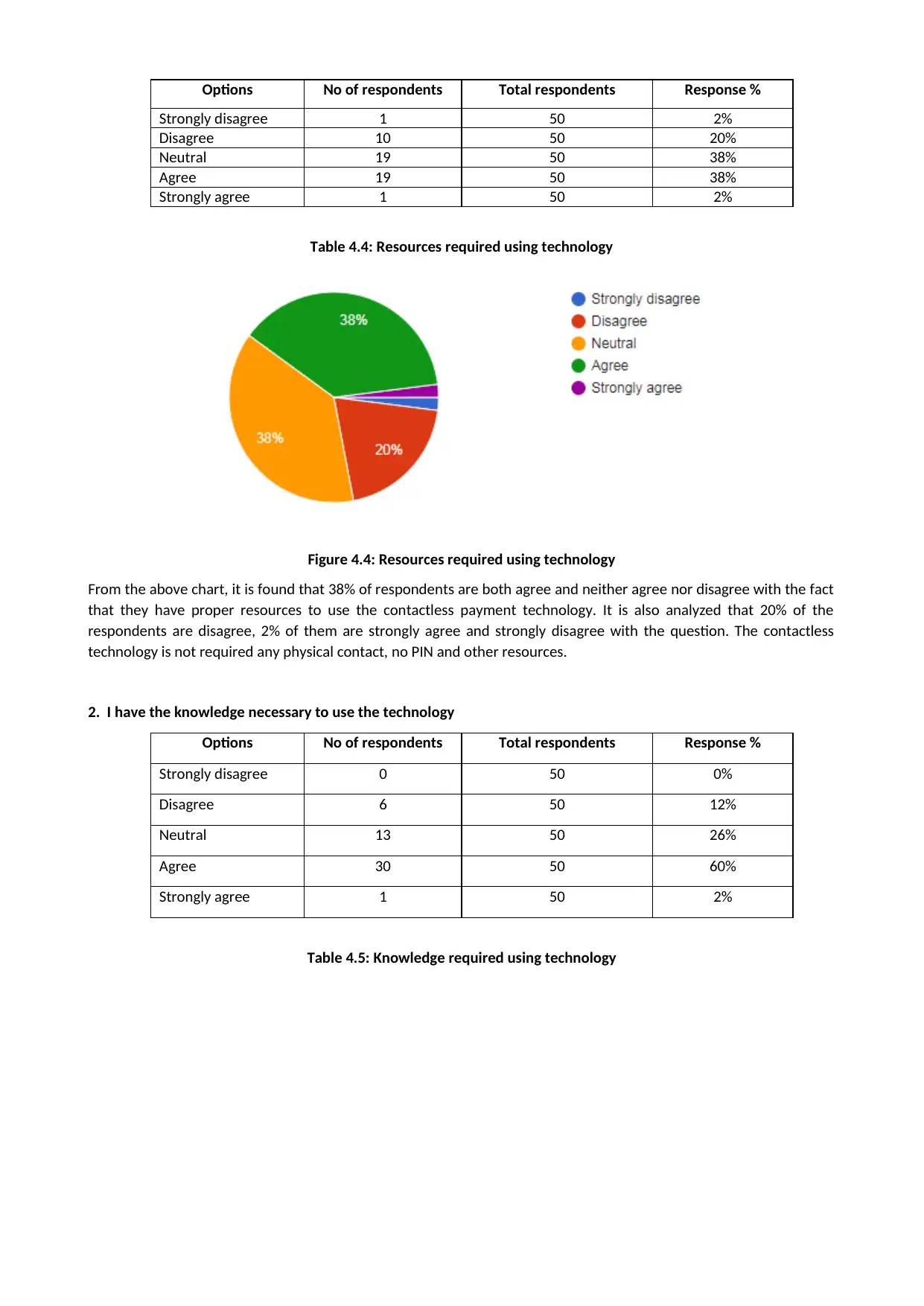
Options No of respondents Total respondents Response %
Strongly disagree 1 50 2%
Disagree 10 50 20%
Neutral 19 50 38%
Agree 19 50 38%
Strongly agree 1 50 2%
Table 4.4: Resources required using technology
Figure 4.4: Resources required using technology
From the above chart, it is found that 38% of respondents are both agree and neither agree nor disagree with the fact
that they have proper resources to use the contactless payment technology. It is also analyzed that 20% of the
respondents are disagree, 2% of them are strongly agree and strongly disagree with the question. The contactless
technology is not required any physical contact, no PIN and other resources.
2. I have the knowledge necessary to use the technology
Options No of respondents Total respondents Response %
Strongly disagree 0 50 0%
Disagree 6 50 12%
Neutral 13 50 26%
Agree 30 50 60%
Strongly agree 1 50 2%
Table 4.5: Knowledge required using technology
Strongly disagree 1 50 2%
Disagree 10 50 20%
Neutral 19 50 38%
Agree 19 50 38%
Strongly agree 1 50 2%
Table 4.4: Resources required using technology
Figure 4.4: Resources required using technology
From the above chart, it is found that 38% of respondents are both agree and neither agree nor disagree with the fact
that they have proper resources to use the contactless payment technology. It is also analyzed that 20% of the
respondents are disagree, 2% of them are strongly agree and strongly disagree with the question. The contactless
technology is not required any physical contact, no PIN and other resources.
2. I have the knowledge necessary to use the technology
Options No of respondents Total respondents Response %
Strongly disagree 0 50 0%
Disagree 6 50 12%
Neutral 13 50 26%
Agree 30 50 60%
Strongly agree 1 50 2%
Table 4.5: Knowledge required using technology
⊘ This is a preview!⊘
Do you want full access?
Subscribe today to unlock all pages.

Trusted by 1+ million students worldwide
1 out of 29
Related Documents
Your All-in-One AI-Powered Toolkit for Academic Success.
+13062052269
info@desklib.com
Available 24*7 on WhatsApp / Email
![[object Object]](/_next/static/media/star-bottom.7253800d.svg)
Unlock your academic potential
Copyright © 2020–2025 A2Z Services. All Rights Reserved. Developed and managed by ZUCOL.





